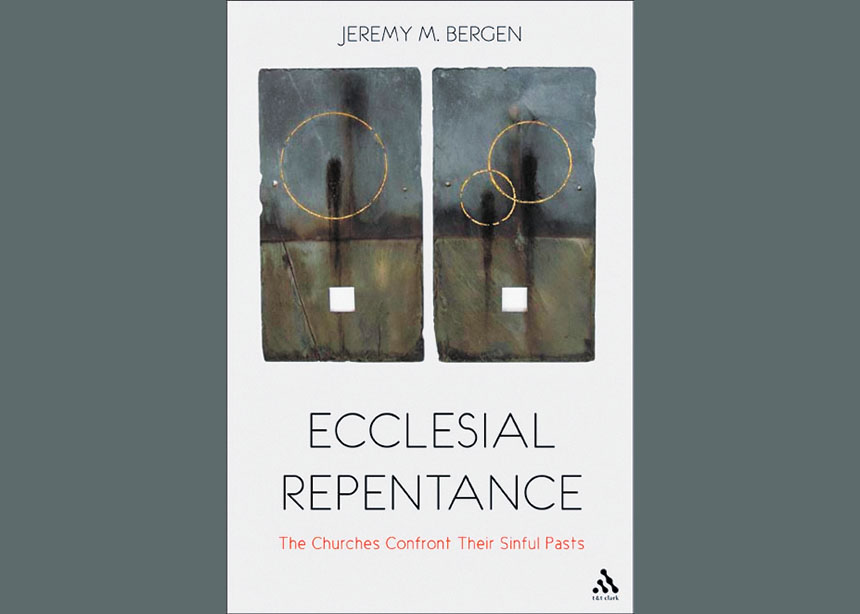A public apology is one of many ways that a church may address past wrongs and those persons who have been harmed. Right now, for example, even following the apology by the Canadian Catholic bishops, there remains a strong call for an apology by Pope Francis for residential schools in Canada and abuses that happened there.
It is helpful to step back and think about the meaning of such statements whether by a pope, a local congregation or Mennonite Church Canada. While I note some biblical and theological points of reference, I also believe there is no formula.
I am not addressing here any of the painful histories for which apologies may be called—Indian Residential Schools, displacement of Indigenous people from land, racism, antisemitism, sexual misconduct of leaders, or inaction on climate change, among others. A very different article would be necessary to argue how MC Canada, for example, should address any one of these very different histories and whether an apology should be part of the response. Because of the long and difficult work of living into an apology, apologies should not be made too often.
What is the sense of an apology?
Does it even make sense for the church in the present to speak to something that happened in the past? Are we judging the past by the standards of the present? The church is constituted as a body by its head, Jesus Christ, and it exists as this body over time. While it is important to avoid a self-righteousness of the present in denouncing past actions, it is also crucial to recognize that forms of oppression that exist today have roots in actions and attitudes of the past. These should be named.
In Ezra 9:5-15, Ezra makes a public prayer of confession for specific sins of his own generation and for generations past. For Ezra, naming past sins enables him to interpret more recent history (the exile and return) and is a basis for a call to specific actions, such a new covenant (10:3). Ezra indeed speaks on behalf of a “we” that extends through space and time.
In Revelation 2-3, we read that some—but not all—of the seven churches are called to repentance by the Spirit. Discernment is needed. The church of Pergamum is called to repent for toleration of false teachers (2:12-17). The “lukewarm” church of Laodicea falsely believes everything is fine (3:14-22). And even though we know each member of the churches of Smyrna and Philadelphia (2:8-11; 3:7-13) was a sinner, those churches were not called to corporate repentance at that moment.
A church apology is not primarily speaking for what individuals have done, but rather about particular patterns that came to characterize the church as a community. For example, in a case of pastoral sexual misconduct, any church apology should generally not speak on behalf of the pastor’s personal responsibility. Rather, a church apology may be a way of naming and confessing a failure of a church system to see a pattern, stopping the abuse and holding an offender to account.
Repentance is a rich biblical concept that entails a change of heart and a change of direction. It can be an inner change, but a public statement may also be an important way to promote accountability. Because churches that address their historical pasts often do so in public ways, they may use the more common language of “apology.” It is appropriate that apology has come to take on theological significance as churches give public witness in this manner.
What does a public apology do?
1. An apology acknowledges that the past cannot be undone, and any statement is inadequate. An apology is never sufficient, but it may nevertheless be a necessary element, or even a turning point, in a larger process
2. An apology names a particular history “for the record.” It identifies what was wrong and sinful in that history, and confesses that the church as a body was responsible. Examining and understanding the history—how a likely mix of good intentions and bad intentions caused the harm in question—is crucial if you want to not repeat it. For a public statement of apology, the challenge is to not be too vague about the history, nor to be too detailed.
3. An apology publicly acknowledges the human dignity of those who were harmed. This requires careful listening and the cultivation of relationships. Thus, it matters not only what is said, but the forum and manner in which it is said.
4. An apology expresses a commitment to the future, and provides for accountability to the commitment. An “inner change” looks different for an individual than it does for a community. It isn’t only a question of whether the leader making a statement on behalf of a church is personally sincere, but whether and how the church will truly change.
An apology may set a tone for difficult, ongoing work ahead. Structures, programs, finances and guidelines may be important for implementing change. So is ongoing prayer and discernment, new relationships and reminders of commitments made.
Questions to ask when considering a public apology
Bearing in mind that an apology may not be appropriate in every situation, here are five questions for a church that is considering a public apology:
1. Are we listening?
The churches in Revelation 2-3 were exhorted to listen to what the Spirit was saying, which was different for each church. In our time, this must include truly listening to the experiences of those who have been harmed by the actions of the church. Those who are powerful in the church do not have the perspective to see what needs to be seen. Listening is the first step.
2. Are we truly sorry?
Do not apologize if you are not convinced a particular history happened, that it was wrong and that the church was responsible. It will only make things worse. Some public apologies express regret that people were harmed, but don’t take responsibility for causing the harm. These seem apologetic but, because they do not reflect responsibility for that past, they are unlikely to followed by meaningful action.
3. Will we ask for forgiveness?
In many cases, it is best that a church not ask for forgiveness, as this can be a means for maintaining control. Asking forgiveness of victims demands a response. This can shift the onus to those with less power to absolve the powerful. It creates a situation in which victims are expected to respond and, because of the power imbalance, may do so before they are truly ready.
Asking forgiveness of God (and usually declaring it granted) can function as a way of declaring the issue closed. This is not to doubt God’s grace, but to affirm that how we talk about that grace matters. We should not do so in a way that forecloses on the long process of being transformed.
There may be times when a request for forgiveness is appropriate, as was the case between the Mennonites and Lutherans, two global communions of relatively equal power, for past persecution and animosity.
4. What actions are required?
Being truly sorry implies not repeating an action and finding ways to repair the damage. An apology commits to walking in a new direction, but it isn’t the walk itself. The walk will be long, difficult and costly.
5. Are we prepared to not be in control?
Sometimes control takes the form of expecting that an apology will bring “closure” to the matter. If this is the expectation, the church is not yet ready to make any statement at all.
Tending the cairn
In his prayer, Ezra throws himself on the mercy of God. A public apology ought to remind the church that it depends for its very existence on Jesus Christ, and not on its good actions or intentions. (Good intentions may well have been part of the problem being acknowledged. And the church should also have the humility to recognize that future generations may need to repent for our present statements of apology.) If a community is truly sorry, it must be open to change and transformation in ways it cannot yet see.
Murray Sinclair, the chair of the Truth and Reconciliation Commission, has spoken about reconciliation as a process in which we don’t know where the path will go. If the church commits to this, it will need to trust the Spirit.
In 1986, the United Church of Canada made an important apology to Indigenous people. An Indigenous group within that church acknowledged the apology, but did not accept it. They said an apology must be lived out. So an unfinished cairn of stones was erected in Sudbury where the original statement was first made. From time to time, stones are added to signal positive developments in the relationship between Indigenous people and settlers in the church. Recalling the apology and tending the cairn thus calls for ongoing conversation and deepening relationships.
Tending the cairn is definitely not reconciliation itself. It is, at most, a marker of a promise to be truly open to transformation, and a focal point for ongoing listening to what the Spirit is saying to the churches.
Jeremy M. Bergen is associate professor of theological studies at Conrad Grebel University College, Waterloo, Ont., and the author of Ecclesial Repentance: The Churches Confront Their Sinful Pasts.
Church apologies over the years
There have been many dozens of church apologies from regional, national and global bodies, including this sample:
- Evangelical (Lutheran) Church in Germany, 1945: “Stuttgart Declaration of Guilt.”
- Pope Paul VI, 1963: Speech to Second Vatican Council (for that church’s role in division among Christians).
- United Church of Christ in Japan, 1967: “Confession on Responsibility During World War II.”
- Conference of Mennonites in Canada, 1970: “A Litany of Confession” to Indigenous People.
- Evangelical (Lutheran) Church of the Rhineland, 1980: “Towards Renovation of the Relationship of Christians and Jews.”
- United Church of Canada, 1986: “Apology to First Nations.”
- Missionary Oblates of Canada, 1991: Apology for Residential Schools.
- Anglican Church of Canada, 1993: Apology for Residential Schools.
- United Methodist Church, 1996: Apology for Sand Creek Massacre.
- Pope John Paul II, 2000: Day of Pardon (for sins “in service of truth,” sins against unity, sins against women, the poor, and the weak).
- French Catholic Bishops, 1997: Drancy Declaration (for complicity in the Holocaust).
- Church of England, 2006: Apology for Slavery and Slave Trade.
- Episcopal Church, 2008: Apology for Slavery.
- Lutheran World Federation, 2010: Statement on Lutheran Persecution of Anabaptists.
- Pope Francis, 2018: Letter on Clergy Sexual Abuse
—Compiled by Jeremy Bergen
For discussion
1. Can you think of apologies that made an impact on you? Why were they memorable? Can relationships remain healthy without apologies? In what situations does an apology feel insincere?
2. How is a public apology different from a private one? Who has the authority to apologize or express repentance for a congregation or a church? How would you answer Jeremy Bergen’s question about whether it makes sense for a church in the present to speak to something that happened in the past?
3. Bergen writes, “Because of the long and difficult work of living into an apology, apologies should not be made too often.” Do you agree? What does it mean to live into an apology? In what situations is it important for a church to issue a public apology?
4. “Some public apologies express regret that people were harmed but don’t take responsibility for causing the harm,” says Bergen. Do you agree that this approach can end up causing more harm? Why is it inappropriate for a church to ask for forgiveness?
5. Bergen says good intentions are not enough. In what ways can good intentions be part of the problem? What does it mean to be “truly open to transformation”?
—By Barb Draper









Leave a Reply
You must be logged in to post a comment.